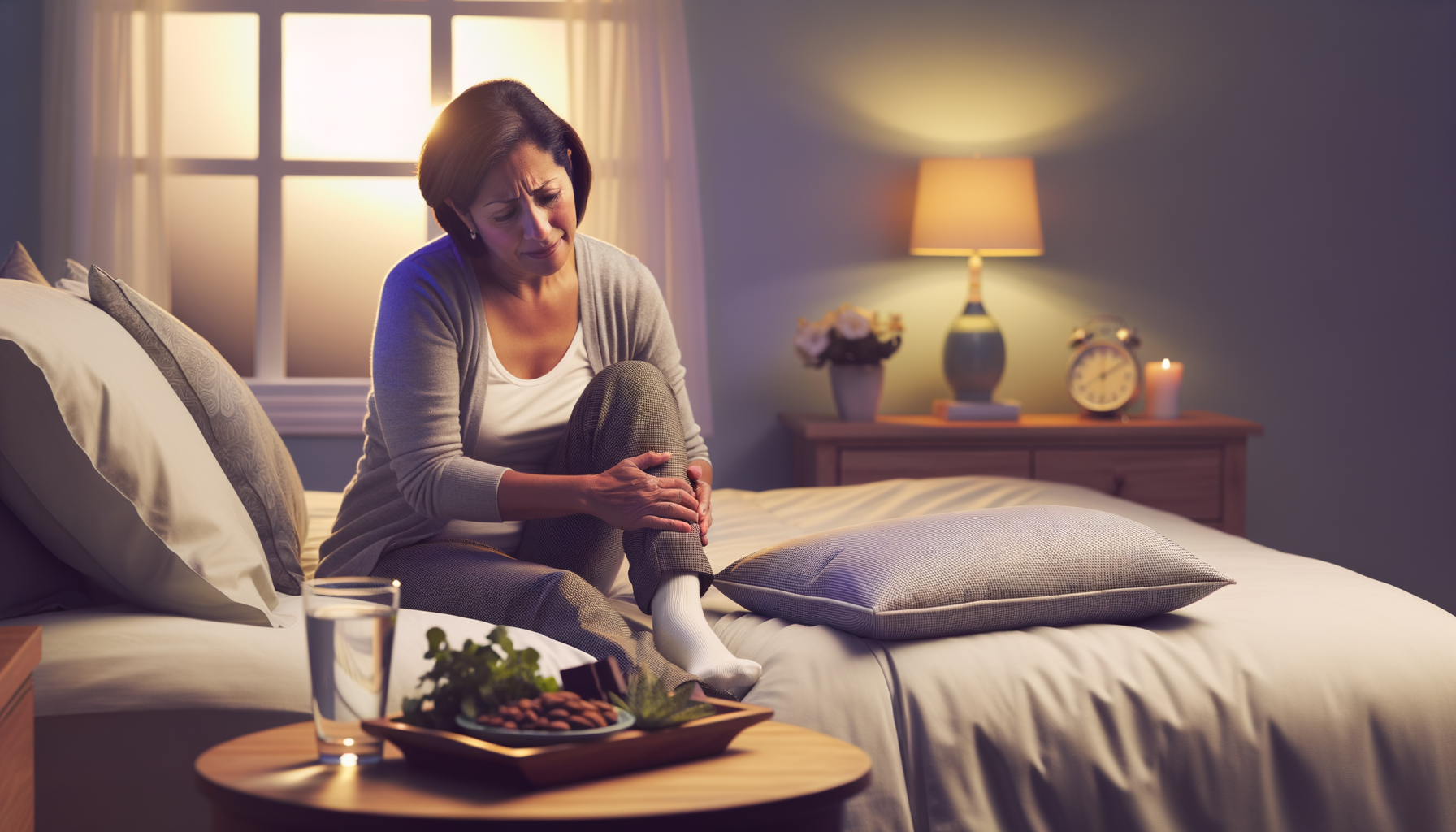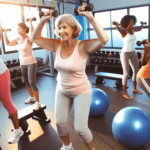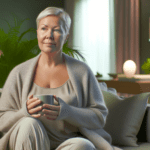Understanding Muscle Cramps and Eye Twitches
Muscle cramps are involuntary and often painful contractions of muscles that can occur in various parts of the body. They are commonly experienced in the legs, particularly in the calf muscles. Eye twitches, or myokymia, are repetitive, involuntary spasms of the eyelid muscles, which are usually harmless and transient. Both muscle cramps and eye twitches can be influenced by a range of factors, including electrolyte imbalances, dehydration, and neurological conditions.
The Link Between Menopause and Muscle Symptoms
Menopause is a natural biological process that marks the end of a woman’s reproductive years, characterized by the cessation of menstruation. This transition is often accompanied by a variety of symptoms, including muscle cramps and aches. The hormonal fluctuations that occur during menopause, particularly the decline in estrogen levels, can affect muscle health and pain perception. Estrogen is known to help regulate the release of the body’s natural painkillers, such as endorphins and enkephalins. As estrogen levels decrease, the efficiency of this process diminishes, potentially leading to an increased sensation of pain and the exacerbation of muscle-related symptoms.
Overview of Hormonal Changes and Muscular Effects
During menopause, the body undergoes significant hormonal changes, most notably a reduction in the production of estrogen and progesterone. These hormones play crucial roles in maintaining muscle and joint health. Estrogen, for instance, has anti-inflammatory properties and contributes to the regulation of mineral absorption, which is vital for muscle function. The decline in estrogen can lead to increased inflammation and may affect the body’s ability to absorb and utilize essential minerals like calcium and magnesium, further contributing to muscle cramps and discomfort. Additionally, the hormonal changes can influence the body’s response to exercise and stress, which may also impact muscle health.
The Science of Muscle Cramps
Defining Muscle Cramps and Their Manifestations
Muscle cramps are sudden, involuntary contractions that occur in various muscles. These intense spasms can cause significant discomfort and pain, often striking without warning. Manifestations of muscle cramps include a hard lump at the site of the cramp, visible twitching of the muscles, and an acute, piercing pain that may make it temporarily impossible to use the affected muscle. Commonly affected areas are the calves, thighs, foot arches, hands, arms, and abdomen.
Common Causes of Muscle Cramps
Several factors contribute to the onset of muscle cramps. Dehydration and electrolyte imbalances, particularly deficiencies in potassium, calcium, and magnesium, are frequent culprits. Cramps may also result from overuse of a muscle, holding a position for a prolonged period, or muscular strain. In addition, inadequate blood supply, nerve compression, and certain medications can trigger muscle cramps. During menopause, hormonal changes may disrupt the balance of minerals and hydration levels, increasing the likelihood of cramps.
The Role of Minerals in Muscle Function
Minerals such as potassium, calcium, and magnesium play a pivotal role in muscle function and health. Potassium is crucial for muscle contractions and nerve function. Calcium is essential for muscle movements and the transmission of nerve signals, while magnesium aids in muscle relaxation and helps regulate calcium levels. An imbalance in these minerals can lead to muscle hyperexcitability and cramps. Ensuring a diet rich in these minerals, alongside proper hydration, can help maintain muscle function and prevent cramps.
For individuals experiencing muscle cramps, it is important to identify the underlying cause and address it appropriately. This may involve dietary adjustments, hydration strategies, and in some cases, medical intervention to correct mineral imbalances or treat underlying health conditions. Regular stretching and exercise can also help prevent muscle cramps by improving circulation and muscle resilience.
Menopause and Its Impact on Muscles
Hormonal Fluctuations and Muscle Health
Menopause is a natural biological process that marks the end of a woman’s reproductive years, but it also brings about a series of hormonal changes that can have a significant impact on muscle health. During menopause, the ovaries gradually decrease the production of estrogen and progesterone, hormones that are not only pivotal for reproduction but also play a role in maintaining muscle function and strength. The decline in estrogen levels is particularly associated with a decrease in muscle mass and strength, a condition known as sarcopenia, which can lead to increased frailty and a higher risk of falls and fractures in postmenopausal women.
Estrogen’s Protective Role in Circulatory Health
Estrogen is known to have a protective effect on heart health, partly due to its influence on the circulatory system. It helps to maintain the elasticity of blood vessels, ensuring adequate blood flow and nutrient delivery to various tissues, including muscles. With the onset of menopause, the reduction in estrogen levels can lead to stiffer blood vessels and compromised circulation. This can result in less oxygen and fewer nutrients reaching the muscles, which may contribute to muscle cramps and fatigue. Additionally, estrogen’s anti-inflammatory properties are diminished during menopause, potentially leading to increased inflammation and associated muscle pain.
Nutrient Absorption During Menopause
Menopause can also affect the body’s ability to absorb and utilize essential nutrients that are critical for muscle health. For instance, changes in hormone levels can impact the absorption of calcium and vitamin D, both of which are vital for strong bones and muscle function. Moreover, the body’s ability to retain and utilize other minerals like magnesium and potassium, which are important for muscle contraction and relaxation, may also be affected. This can lead to a higher incidence of muscle cramps and spasms among menopausal women. Ensuring a diet rich in these nutrients, along with appropriate supplementation when necessary, is crucial for maintaining muscle health during and after the menopausal transition.
Natural Management of Muscle Cramps
Lifestyle Changes to Alleviate Muscle Cramps
Muscle cramps can be a common and uncomfortable symptom during menopause, but certain lifestyle changes can help alleviate their frequency and severity. Firstly, maintaining a regular exercise routine within safe limits is crucial. Activities such as yoga and Pilates not only support good posture but also enhance muscle flexibility and strength. It’s important to warm up before and cool down after exercise to prevent cramps. Additionally, optimizing your workspace for ergonomics can reduce the risk of muscle strain. Regular breaks to stretch and move around during long periods of sitting can also be beneficial. Lastly, ensuring you have a supportive mattress and pillow can improve sleep posture, potentially reducing nighttime cramps.
Dietary Adjustments for Muscle Health
A balanced diet plays a pivotal role in muscle health. Menopausal women should focus on consuming adequate amounts of calcium, magnesium, and vitamin D, as these nutrients are vital for muscle function and bone health. Foods rich in these minerals, such as leafy greens, nuts, seeds, and dairy products, should be included in the diet. Staying hydrated is equally important, as dehydration can trigger muscle cramps. Some anecdotal evidence suggests that consuming small amounts of pickle juice or mustard, which contain strong spices, may provide quick relief from cramps due to their sensory impact on the palate and esophagus.
Physical Therapies and Exercises
Engaging in specific physical therapies and exercises can help manage muscle cramps effectively. Targeted stretches held for 20 seconds in three repetitions can activate and loosen muscles prone to cramping. Strength-building exercises, such as medial leg lifts and knee-to-chest raises, can also be beneficial. For those with conditions like osteoarthritis, low-impact exercises may be more suitable. Consulting with a physical therapist or a fitness instructor can provide personalized advice on starting safely and preventing injuries.
Heat and Cold Treatments
Applying heat or cold to affected muscles can provide immediate relief from cramps. Heat therapy, through a warm bath or a heating pad, can relax tight muscles and improve blood flow. Conversely, cold therapy with an ice pack can reduce inflammation and numb the pain. It’s essential to use these treatments correctly, typically by applying heat or cold for 15-20 minutes at a time and ensuring there’s a protective layer between the skin and the source of heat or cold to prevent skin damage.
By incorporating these natural management strategies, women experiencing menopause can mitigate muscle cramps and improve their overall muscular health. However, if cramps persist or worsen, it is advisable to seek medical advice to rule out any underlying conditions.
Addressing Eye Twitches in Menopause
Understanding Eye Twitches and Their Causes
Eye twitches, medically known as myokymia, are involuntary spasms of the eyelid muscles. These can range from a slight spasm that is barely noticeable to a more pronounced twitch that can be bothersome. While eye twitches are common and often harmless, they can be a source of irritation and concern, particularly when they occur frequently or persist over time.
During menopause, hormonal fluctuations can contribute to the occurrence of eye twitches. The decline in estrogen levels can affect nerve and muscle function, potentially leading to spasms. Additionally, menopause can bring about lifestyle changes and stressors that may exacerbate eye twitching. Factors such as fatigue, stress, dry eyes, and nutritional imbalances are also known to trigger or worsen this condition.
Lifestyle and Environmental Factors
Lifestyle choices and environmental factors can play a significant role in the frequency and severity of eye twitches. Extended periods of screen time, poor lighting, and lack of sleep can strain the eyes, leading to twitching. Moreover, the consumption of caffeine and alcohol may increase the likelihood of experiencing eye spasms. It’s important to evaluate daily habits and make adjustments to reduce the occurrence of eye twitches.
Stress-Reduction Techniques
Stress is a common trigger for eye twitches, and managing stress levels can be an effective way to alleviate this symptom. Techniques such as deep breathing exercises, meditation, yoga, and regular physical activity can help reduce stress. Additionally, ensuring adequate rest and relaxation time is crucial for overall well-being and can help minimize the frequency of eye twitches.
Eye Care and Screen Time Management
- Take Regular Breaks: Follow the 20-20-20 rule when using screens—every 20 minutes, look at something 20 feet away for at least 20 seconds.
- Adjust Lighting: Ensure your work and living spaces are well-lit to reduce eye strain. Avoid harsh or flickering lights.
- Use Artificial Tears: Over-the-counter lubricating eye drops can help if dry eyes are contributing to twitching.
- Limit Caffeine: Reducing intake of caffeinated beverages may decrease the occurrence of eye twitches.
- Optimize Sleep: Aim for 7-9 hours of quality sleep per night to help prevent fatigue-related eye twitches.
By understanding the causes of eye twitches and implementing lifestyle changes, individuals going through menopause can better manage this symptom. If eye twitches persist or are accompanied by other symptoms, it is advisable to seek medical attention to rule out other potential causes.
When to Seek Medical Advice
Identifying Serious Symptoms
While muscle cramps and eye twitches can be common during menopause, certain symptoms should prompt immediate medical attention. Seek urgent care if you experience:
- Severe muscle pain or cramps that come on suddenly and are not relieved by rest or home remedies.
- Swelling, redness, or warmth in the affected muscles.
- Signs of infection, such as fever or a feeling of general unwellness.
- Cramps that occur alongside changes in skin color or sensation.
- Any new or unusual symptoms that accompany muscle cramps, such as difficulty breathing or chest pain.
Frequency and Severity of Muscle Cramps
Occasional muscle cramps may not be a cause for concern, but if you notice an increase in the frequency, duration, or intensity of cramps, it’s time to consult a healthcare provider. Persistent or worsening cramps can indicate underlying health issues that may require medical intervention.
Persistent Eye Twitching Concerns
Eye twitches are typically harmless and often resolve on their own. However, if twitching persists for an extended period, becomes painful, or is accompanied by other facial spasms or a drooping eyelid, these could be signs of a more serious condition. In such cases, it’s important to seek medical advice to rule out neurological disorders or other health concerns.
Lack of Improvement with Natural Remedies
Many women find relief from menopause-related muscle cramps and eye twitches through natural remedies and lifestyle changes. However, if you’ve tried these methods and have not seen any improvement after a few weeks, or if symptoms worsen, it’s advisable to consult with a healthcare professional. They can assess whether further treatment or investigation is needed, such as blood tests to check for deficiencies or imbalances that could be contributing to your symptoms.
In conclusion, while menopause-related muscle cramps and eye twitches are often manageable with self-care, it’s crucial to be vigilant about changes in your symptoms. Always err on the side of caution and seek medical advice if you experience severe, persistent, or worsening symptoms, or if natural remedies fail to provide relief. Your healthcare provider can help determine the cause of your symptoms and recommend appropriate treatment options.

From unhappy, dry, and sandpaper to silky, smooth and feeling good. That’s Cleo. Cleo is a 100% natural labial balm to moisture and soothe “your other lips”. Cleo is chemical-free, water-free, pH optimized and helps maintain and restore your delicate labial skin’s natural flora. Ideal for daily use or as needed. Get the most silky, lovable lips ever.
Conclusion: Living with Menopause-Related Muscle Cramps
Summarizing the Impact of Hormonal Changes
Menopause marks the end of a woman’s reproductive years, accompanied by significant hormonal changes, particularly a decline in estrogen levels. This hormonal upheaval can have a profound impact on various bodily functions, including muscle health. Estrogen plays a crucial role in maintaining muscle mass and strength, and its decline can lead to increased muscle cramps and aches. Additionally, estrogen’s influence on pain perception means that postmenopausal women may experience muscle cramps more intensely. While hormone replacement therapy (HRT) has been considered, it does not universally improve the perception of pain and is not a one-size-fits-all solution due to mixed research findings and potential health risks.
Effective Management Through Lifestyle
Lifestyle modifications can be a cornerstone in managing menopause-related muscle cramps. Regular physical activity, particularly strength training and stretching exercises, can help maintain muscle mass and flexibility, reducing the frequency and severity of cramps. Dietary adjustments are also paramount; ensuring adequate intake of minerals like calcium, magnesium, and potassium supports muscle function and may alleviate cramping. Additionally, staying hydrated and maintaining a healthy weight can prevent muscle cramps, as excess body weight can strain muscles, and dehydration can trigger cramping.
The Importance of Monitoring Symptoms
It is essential for postmenopausal women to monitor their symptoms closely. Persistent or severe muscle cramps, especially when accompanied by other concerning signs such as swelling or redness, warrant medical attention. These symptoms could indicate underlying conditions like osteoarthritis or thyroid issues, which may exacerbate muscle cramps. Regular check-ups and open communication with healthcare providers ensure that any serious causes of muscle cramps are identified and treated promptly. Moreover, if natural remedies and lifestyle changes fail to provide relief, seeking medical advice is crucial for exploring other treatment options.
In conclusion, while hormonal changes during menopause can lead to muscle cramps, these can often be effectively managed through lifestyle interventions and close symptom monitoring. By understanding the impact of these hormonal shifts and adopting proactive measures, women can mitigate the discomfort of muscle cramps and maintain a good quality of life during their postmenopausal years.











